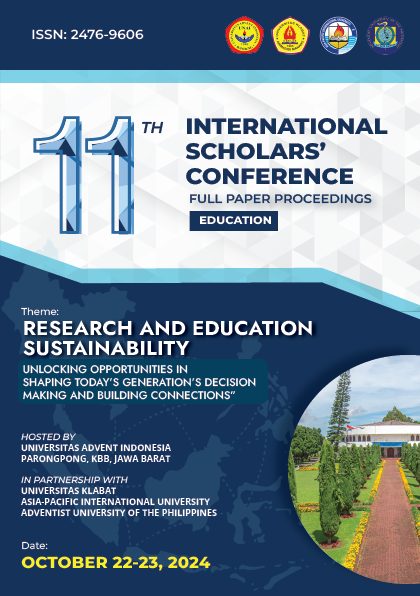Unveiling Similes in Pegasus and the Rise of the Titans
Keywords:
Classic Fantasy, Homeric or Epic Simile, Mythology, Traditional Rhetoric Simile, Young AdultAbstract
Similes help set the tone and mood while making writing more vivid, immersive, and engaging for readers. The aim of this research identifies, interprets, and classifies the similes in the Pegasus and the Rise of the Titans. This research seeks to identify and analyze the use of similes in the Pegasus and the Rise of the Titans and classify the type of simile. This study employs a qualitative descriptive methodology. This study gathered the data from Kate O'Hearn's novel the Pegasus and the Rise of the Titans, book 5. The research findings reveal that 20 sentences in the Pegasus and the Rise of the Titans contain similes, with 14 sentences categorized as Traditional Rhetoric similes and 6 classified as Homeric or Epic similes. The data also reveal that there are 7 sentences use "as," 11 sentences that use "like," and 2 sentences that use both "as" and "like" in a single sentence.
Downloads
References
Central Research Unit. Retrieved on September 20, 2024 from https://pegasuslegend.fandom.com/wiki/Central_Research_Unit
Chinea, C. (2023). Literature examples for teaching homeric similes in The Odyssey. Retrieved on September 17, 2024, from https://blog.flocabulary.com/homeric-simile-examples/#:~:text=An%20epic%20simile%2C%20also%20known,subjects%20is%20explored%20in%20great
Colston, H. L. (2015). Using figurative language. Cambridge University Press.
Dancygier, B., & Sweetser, E. (2014). Figurative language. Cambridge University Press.
del Pilar Salas-Zárate, M., Alor-Hernández, G., Sánchez-Cervantes, J. L., Paredes-Valverde, M. A., García-Alcaraz, J. L., & Valencia-García, R. (2020). Review of English literature on figurative language applied to social networks. Knowledge and Information Systems, 62(6), 2105-2137.
Difference between Simile and Metaphor. Retrieved on September 19, 2024 from https://www.javatpoint.com/difference-between-simile-and-metaphor
Deignan, A., Littlemore, J., & Semino, E. (2013). Figurative language, genre, and register. Cambridge University Press.
Hayeesa-i, T., & Maisarah, I. (2023). Similes analysis in Thai literature: A case study of" The happiness of Kati" in the English version. Journal of Applied Studies in Language, 7(2), 216-226.
Homeric Simile. Retrieved on September 19, 2024 from
Kate O'Hearn. (2024). https://en.wikipedia.org/wiki/Kate_O%27Hearn.
Landis, H. (2022). What is a Simile: Definition, types, and examples. Retrieved on September 2, 2024 from https://www.skillshare.com/en/blog/what-is-a-simile-definition-types-and-examples/
Marpaung, M. S. (2025). The figurative language analysis in “The Chronicles of Narnia: The Last Battle, Book 7” by C. S. Lewis. Acuity: Journal of English Language Pedagogy, Literature and Culture, 10(1). https://doi.org/10.35974/acuity.v10i1.3366
Natanael, Y. T., Indriani, G., Nugraha, M. R. F., & Handayani, N. D. (2022). An analysis of simile in War Room movie. INTERACTION: Jurnal Pendidikan Bahasa, [online], 9(2), 289-296.
O’Hearn, K. (2015). Pegasus and the Rise of the Titans. Hodder Children’s Books.
Pegasus and the Rise of the Titans. Retrieved on September 20, 2024 from https://pegasuslegend.fandom.com/wiki/Pegasus_and_the_Rise_of_the_Titans?veaction=edit§ion=2
Putri, E. A., Pardede, T. R. B., & Bahri, S. (2022). Similes in George Bamber’s Return to Dust. CALL, 4(1).
Sandelowski, M. (2000). Whatever happened to qualitative description? Research in Nursing & Health, 23, 334–340.
Sangki, J. E., Kumayas, T. A., & Rorimpandey, R. S. (2024). An analysis of simile found in Adele’s song lyrics. JoTELL: Journal of Teaching English, Linguistics, and Literature, 3(4), 397-409.
Scott, W. C. (2009). The Artistry of the Homeric Simile. University Press of New England. https://collections.dartmouth.edu/ebooks/scott-artistry 1974.html#epubcfi(/6/6[copy]!/4/2/2[page_iv]/2/2/1:0)
Siregar, S. R., & Pane, W. (2020). Simile in Harry Potter and The Chamber of Secrets. English Education: English Journal for Teaching and Learning, 8(2), 201–215.
Simile. (2024) Retrieved on September 17, 2024 from https://www.merriam-webster.com/dictionary/simile.
Simile and Metaphor (2024). Retrieved on September 20, 2024 from https://www.britannica.com/dictionary/eb/qa/Similes-and-Metaphors
Sinaga, A. G. O., & Marpaung, M. S. (2023). Metaphorical expression used in poetry in the book" The Everyday Poet" by Deborah Alma. ELTALL: English Language Teaching, Applied Linguistic and Literature, 4(1), 77-85.
Tulung, M. R., Maru, M. G., & Kumayas, T. (2021). The Analysis of Simile in Taylor Swift’s Songs. SoCul: International Journal of Research in Social Cultural Issues, 1(6), 374-384.
Downloads
Published
How to Cite
Issue
Section
License
Copyright (c) 2024 11th International Scholars Conference

This work is licensed under a Creative Commons Attribution-ShareAlike 4.0 International License.
Copyright © 2024 ISC Committee.















